Flavor and taste characteristics of Costa Rican coffee beans introduction to the history of planting varieties in Costa Rican coffee producing areas
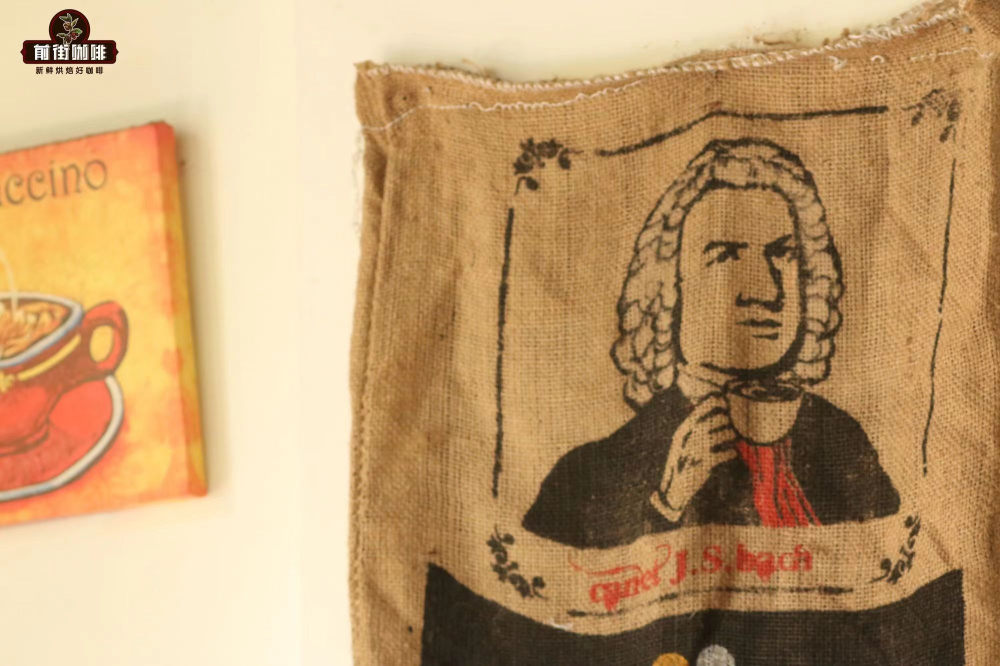
Costa Rican coffee is often sweet fruit flowers, rich and unrestrained aroma, fresh and sour pleasant. There are also several Costa Rican coffee beans on the bean list on the front street, which has such a charming flavor that Qianjie believes that this is inseparable from the careful cultivation of Costa Rica and its unique and diverse honey treatment.
Costa Rica
From the map, you can see that Costa Rica is located in the isthmus of Central America, with Nicaragua in the north and Panama in the southeast.

The whole country of Costa Rica is connected by high mountains. CentralPlateau in the central plateau has volcanic topography, fertile volcanic ash soil with low acidity, suitable temperature and climate throughout the year, and stable and abundant rainfall. Various factors have made coffee here a major local agricultural product.
History of coffee cultivation
Costa Rica, as the first Central American country to introduce coffee tree cultivation, has a long history of coffee cultivation and has quite mature coffee production technology. Coffee was introduced to Costa Rica from Cuba in 1729 and has been cultivated for nearly 300 years. Since breaking away from Spanish colonization in 1821, the local government has given farmers free coffee seeds through land concessions and encouraged the promotion of cultivation. Data from the Costa Rican Coffee Association (ICAFE) show that there are now 29918 coffee growers, reflecting the prevalence of coffee cultivation in Costa Rica.
In addition, the Costa Rican government has a strict regulatory system and sound laws on the coffee industry, and in 1989 banned the cultivation of poor-quality Robusta varieties of coffee. In 2001, the Costa Rican Coffee Association regulated the coffee industry and launched the National Coffee Plan, which required each coffee producing area to sign a quality improvement agreement and processors promised to accept and process only mature coffee beans, thus ensuring the quality of coffee beans.
Coffee producing area
Costa Rica has eight main coffee producing areas, Brunca, Turrialba, Tres R í os, Orosi, Tarraz ú, Valle Central, Valle Occidental and Guanacaste.
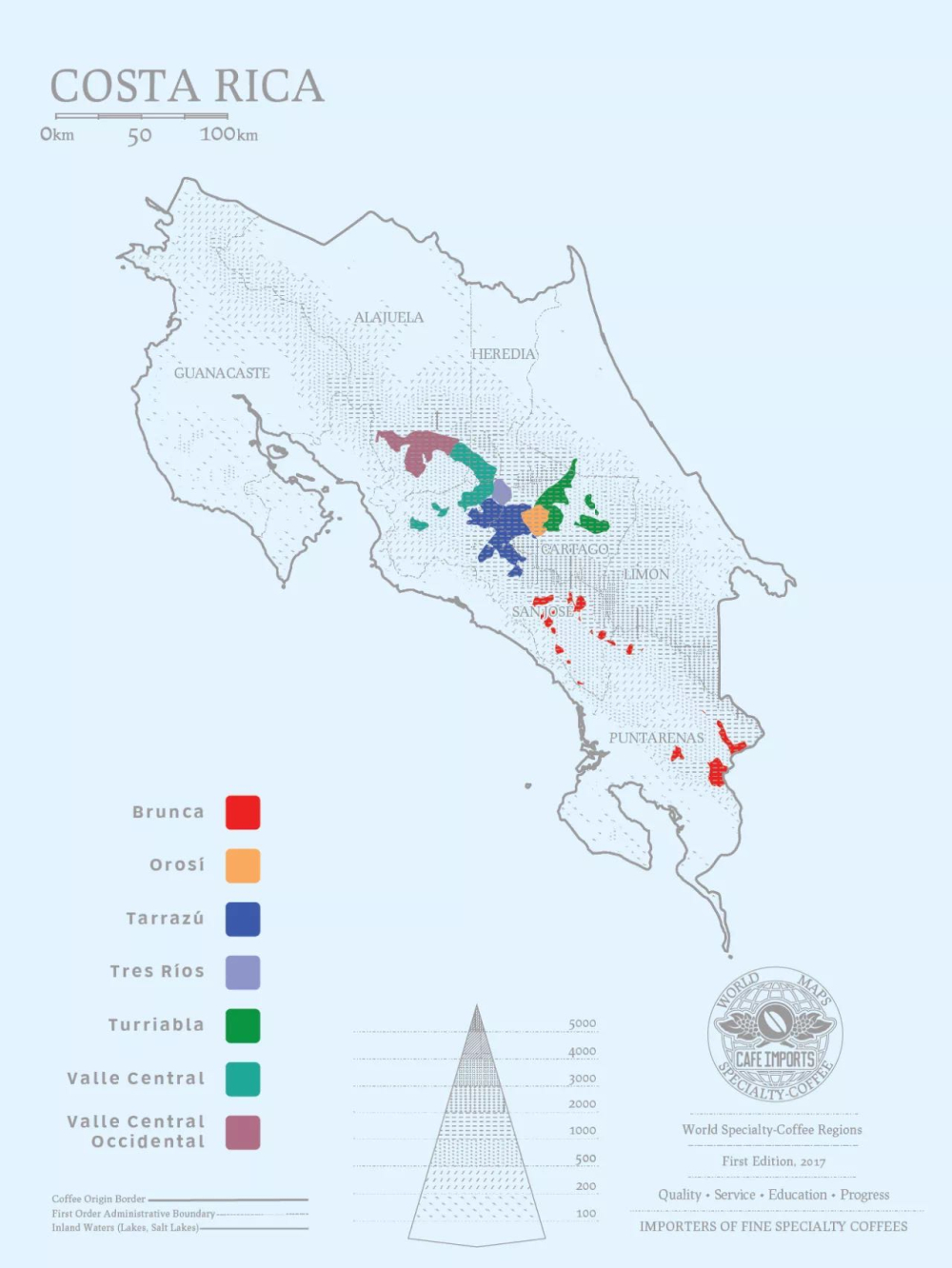
The altitude, climate and soil characteristics of each producing area are different, so the flavor of coffee has its own characteristics. Among them, the Tarazhu producing area with the highest elevation is also the most well-known producing area. Qianjie believes that the flavor of washed Tarazu coffee can best represent the characteristics of Costa Rican coffee, so it chooses washed Tarazhu as Costa Rican rations beans.
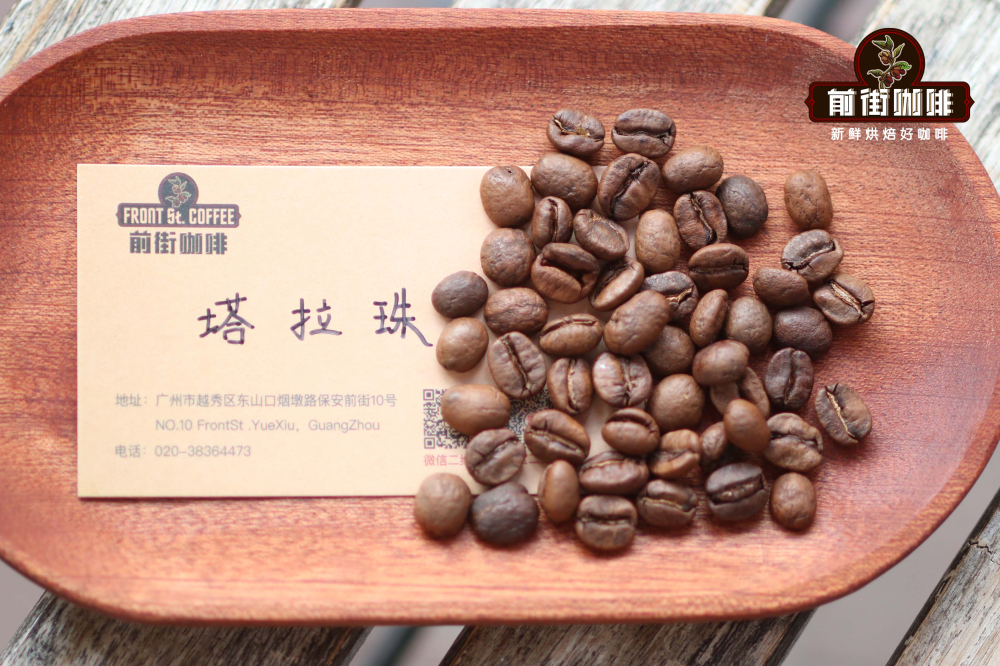
Front Street Coffee: Costa Rica Tarazu Coffee beans
Producing area: Tarazhu, Costa Rica
Altitude: 1500 m
Variety: Kaddura, Kaduai
Treatment: washing treatment
Flavor: orange, honey, toffee, nuts
Tarazhu producing area
The coffee in Tarazhu producing area is different from other producing areas because of its high altitude, about 1200-1700 meters, which increases the temperature difference between day and night, and the coffee fruit takes longer to mature and absorbs more nutrients. The harvest season of coffee is from December to March. The coffee at high altitude is hard and full, with high acidity and outstanding fruit flavor.
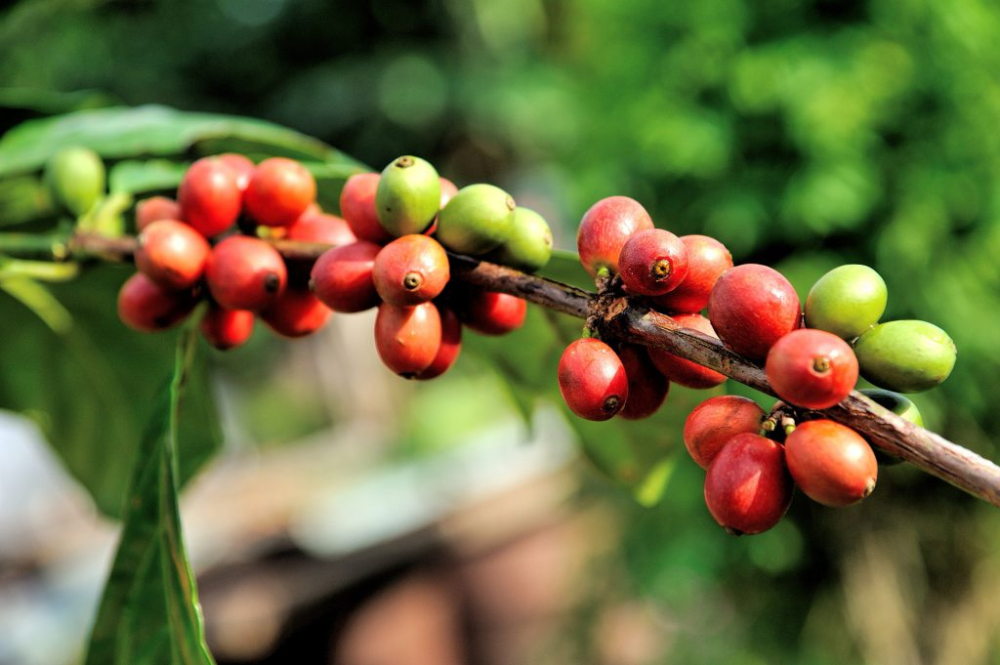
As a well-known local producing area, Tarazhu is located in the south of San Jose, the capital of Costa Rica, and the cultivation and management of coffee is highly valued. Tarazhu coffee is mainly grown in Raminita, where congenital superior soil conditions, do not need to apply too much fertilizer, manual harvest and selection to make the quality of coffee cherries better.
Honey treatment
There are four common ways to treat raw beans of Costa Rican coffee: sun drying, water washing, honey treatment and red wine fermentation, in addition to the classical sun drying treatment and the more common water washing treatment in Central America, the local innovative honey treatment.
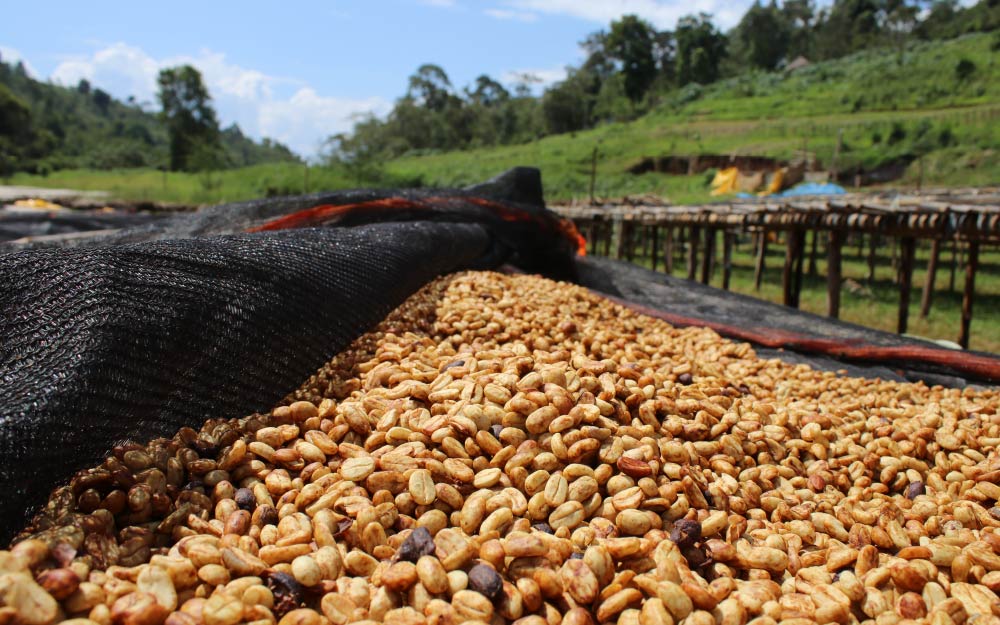
Farmers take off the peel and pulp of the picked coffee fruit through the machine, and dry the coffee beans with pectin layer in the sun. the pectin layer has high sugar content, and the sugar and aroma substances of the berries will ferment together with the shell beans in the drying process, making the juice feeling of coffee beans richer and the aroma more complex. Therefore, this kind of half-sun treatment is called "honey treatment".
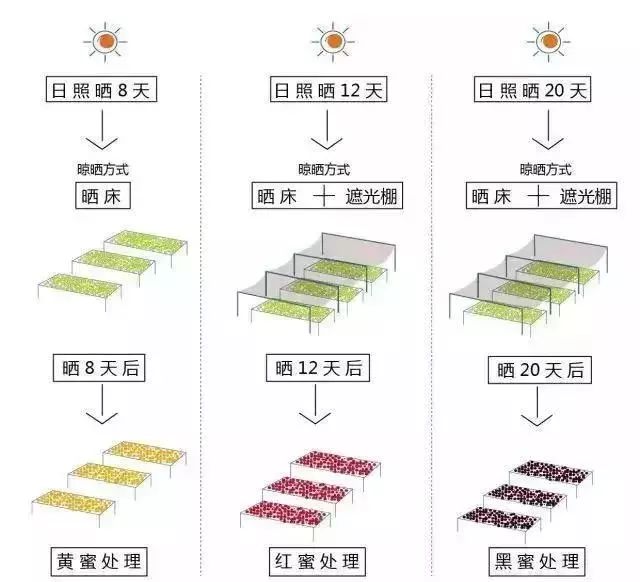
According to different degrees of preservation of pectin layer mucosa, it can be divided into yellow honey, red honey and black honey. Yellow honey retains 60% pectin, red honey retains 75% pectin, and black honey hardly removes the pectin layer for sun-drying. The thickness of pectin layer is different, the time required for drying is also different, high temperature will accelerate the pectin fermentation of coffee pulp, prone to mildew or excessive fermentation, resulting in negative flavor. The advantage of honey treatment is that it consumes less water and does not need large sinks and drying grounds, so it is very suitable for local micro-processing plants in Costa Rica.
With the popularity of boutique coffee, more and more micro-batches of coffee appear, and honey treatment begins to "change pattern" gradually. Unlike the above three honey treatments, raisin honey-treated coffee represented by musicians is also popular.
Before the honey treatment, put the coffee fruit into the sink, pick out the floating defective beans, then dry them in the sun (more than three days), wait for the coffee fruit to become a "raisin" state, and then use a machine to remove the peel and pulp. Continue the steps of honey treatment. This kind of treatment has higher requirements for the control of drying time, and the sweetness of flavor is more layered. The front street musician series Mozart, Bach and so on are treated in this way.
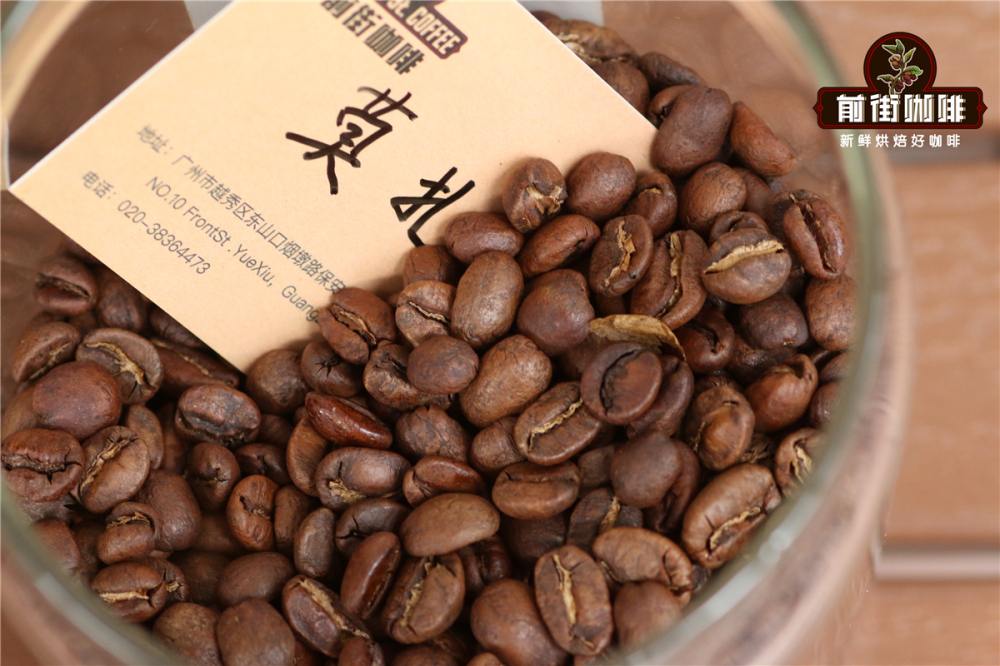
Front Street Coffee: Mozart Coffee beans
Producing area: Tarazhu producing area of Costa Rica
Manor: Carnett Manor
Altitude: 1900 m
Variety: Kaddura, Kaduai
Treatment method: raisin anaerobic honey treatment
Flavor: raisin sweet-scented osmanthus orange berry pineapple
Coffee varieties and raw bean grades
The main varieties of coffee in Costa Rica are Kaddura and Kaduai.
Kaddura Caturra, a variety of bourbon, was discovered by Brazilians in 1927. It has better yield and disease resistance than bourbon. The tree is short, easy to harvest and can grow well without shade trees. Beans are also shaped like bourbon, with a bright flavor and comfortable sweetness. Kaduai is a hybrid of Kaddura and New World, so it is characterized by the low tree shape of Kaddura. The result will be more solid than Kaddura and will not be easily blown down by the strong wind. The flavor highlights the aroma of fresh fruit.
Costa Rican coffee beans can be divided into three types according to the altitude, the extremely hard beans SHB above 1500 meters, the excellent beans GHB growing at 1100-1500 meters above sea level, and the hard beans HB below 1000 meters. Extremely hard beans grow in higher altitude areas, the acidity will be significantly higher than other areas, the flavor is more rich, the front street washed Costa Rica Tara beads rations beans is to choose full-grained GHB very hard beans.
Cooking suggestion
To drink the flavor of different treatments in Costa Rica, the front street is opposite washed Tara beads and Mozart treated with raisin anaerobic honey. For coffee novices, Qianjie has a little advice. To understand the representative flavor of a coffee producing area, start with washing. It is not difficult to find that most of the rations beans in Qianjie are washed with water, because Qianjie thinks that only in this way can we drink the basic flavor of the producing area, and then choose the flavor type we like.
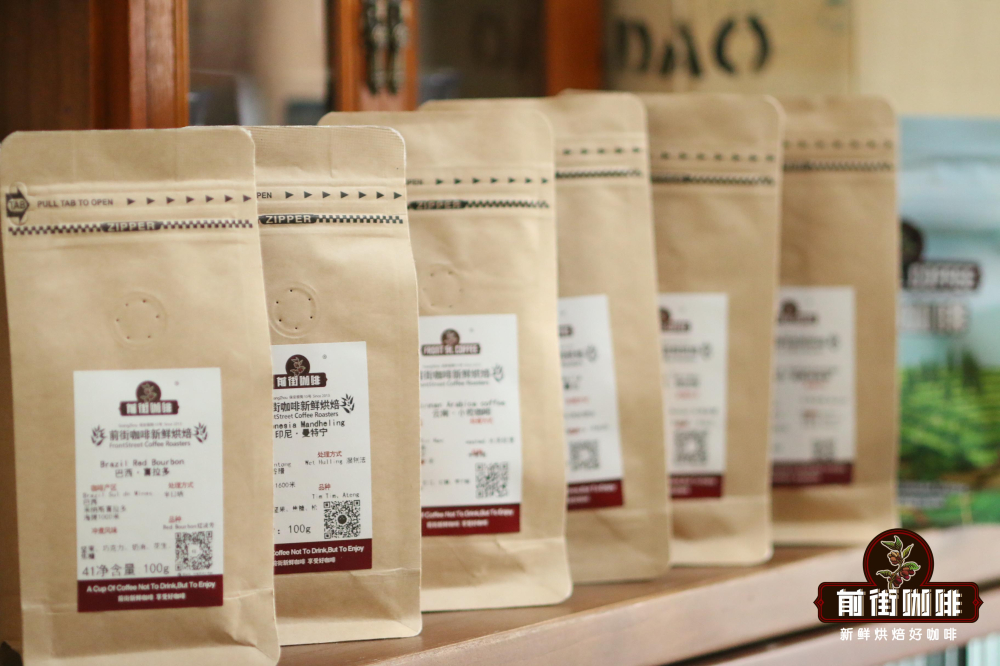
To flush out the aroma of Costa Rican coffee beans, the front street recommends the use of freshly roasted coffee beans. The beans sold in Qianjie Coffee are all baked within 5 days, and they are brewed when they receive the coffee after the delivery of the order, which is just within the best taste period, because Qianjie knows that freshness has a very important effect on the flavor of coffee.
If there is no bean grinding equipment at home, Qianjie can provide grinding service. As the aroma of coffee will accelerate volatilization after grinding beans, so if you want to drink a fuller flavor, Qianjie believes that it can also be equipped with grinding equipment according to its own conditions.
For roasting, choose the flower and fruit aroma of medium-light roasted coffee in front of the street. Because hard beans at high altitude need higher water temperature to stimulate the aroma, the grinding degree of fine sugar can make the fruit flavor of coffee more intense.
Filter cup: V60
Water temperature: 91 ℃
Amount of powder: 15g
Powder / water ratio: 1:15
Degree of grinding: 20 standard screen pass rate 80%
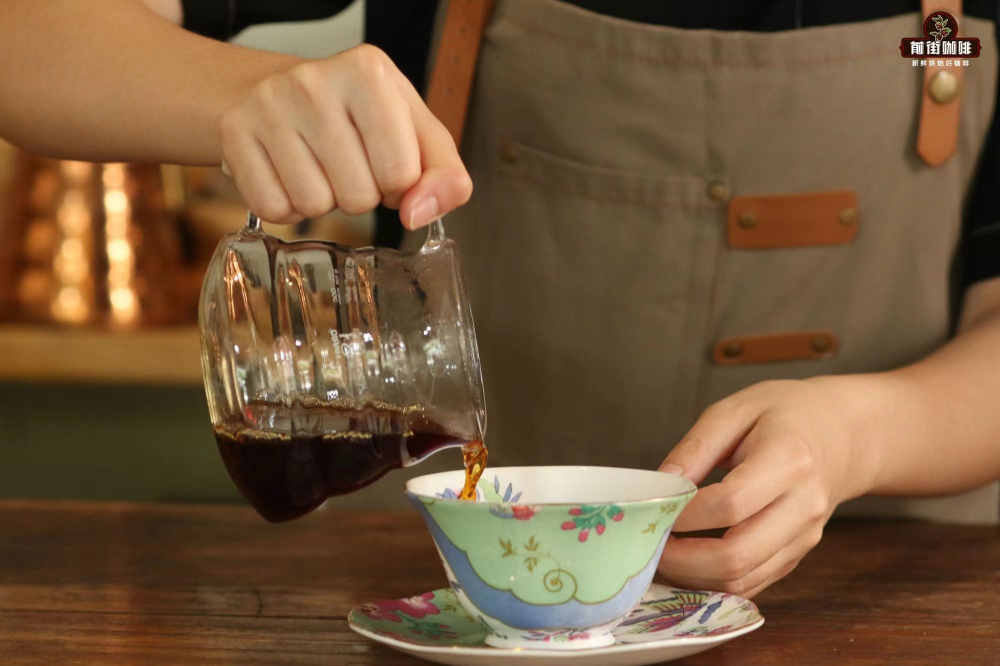
Washed Tara beads rations beans can smell the aroma of nuts and chocolate after grinding, and the entrance is clear and clean sour and sweet berries. After being ground with raisin anaerobic honey, Mozart can smell rich aromas of raisins and sweet-scented osmanthus, the entrance of coffee is rich in tropical fruit fermentation like cantaloupe, and the acidity is softer when the temperature drops, just like scented tea.
Professional coffee knowledge exchange more coffee bean information please follow the coffee workshop (Wechat official account cafe_style)
For more boutique coffee beans, please add private Qianjie coffee on Wechat. WeChat account: qjcoffeex
Important Notice :
前街咖啡 FrontStreet Coffee has moved to new addredd:
FrontStreet Coffee Address: 315,Donghua East Road,GuangZhou
Tel:020 38364473
- Prev
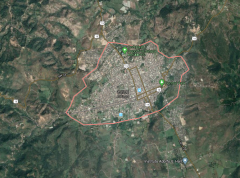
Introduction of Harappa Coffee production area in Guatemala characteristics of Pana Manor Honey in the treatment of Geisha Coffee beans
Harappa is located between Farhanis and New Oriental. Twenty years ago, no one believed that coffee could grow in this area. Farmer Abel Valladares (owner of Pina Manor) is an agronomist who believes that the microclimatic conditions on the Harappa hills are an ideal environment for growing coffee, and he planted the Pacas variety 42 kilometers.
- Next

How does the moisture content of raw coffee beans affect coffee roasting? What are the ways of roasting coffee beans?
In every stage of the coffee industry chain, the moisture content of raw beans must be reduced to avoid defects and defects caused by moldy raw beans. Proper preservation can even improve the value of raw beans. Ensuring proper drying of beans is important to optimize their quality potential and to minimize the possibility of problems. The role closest to the end of the supply chain, the bean baker, has two tasks to control the moisture content.
Related
- Beginners will see the "Coffee pull flower" guide!
- What is the difference between ice blog purified milk and ordinary milk coffee?
- Why is the Philippines the largest producer of crops in Liberia?
- For coffee extraction, should the fine powder be retained?
- How does extracted espresso fill pressed powder? How much strength does it take to press the powder?
- How to make jasmine cold extract coffee? Is the jasmine + latte good?
- Will this little toy really make the coffee taste better? How does Lily Drip affect coffee extraction?
- Will the action of slapping the filter cup also affect coffee extraction?
- What's the difference between powder-to-water ratio and powder-to-liquid ratio?
- What is the Ethiopian local species? What does it have to do with Heirloom native species?

